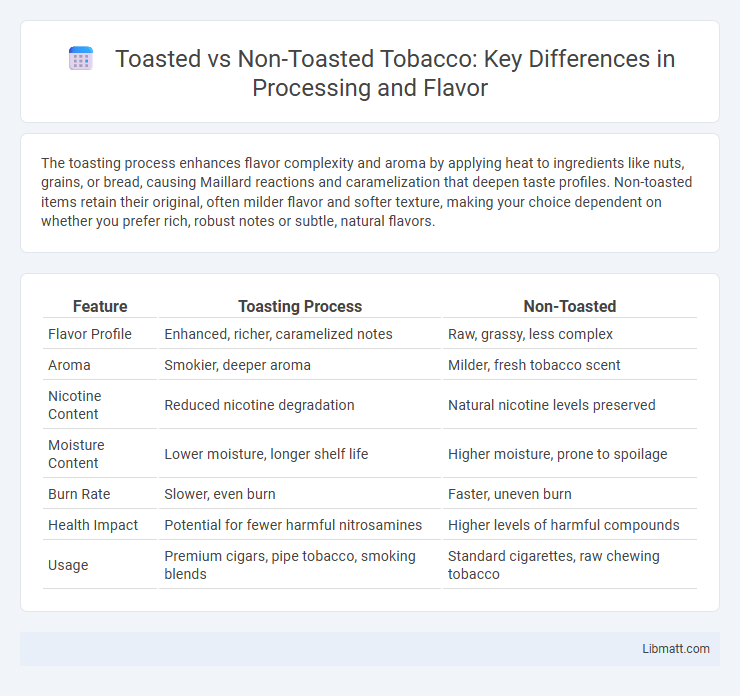The toasting process enhances flavor complexity and aroma by applying heat to ingredients like nuts, grains, or bread, causing Maillard reactions and caramelization that deepen taste profiles. Non-toasted items retain their original, often milder flavor and softer texture, making your choice dependent on whether you prefer rich, robust notes or subtle, natural flavors.
Table of Comparison
| Feature | Toasting Process | Non-Toasted |
|---|---|---|
| Flavor Profile | Enhanced, richer, caramelized notes | Raw, grassy, less complex |
| Aroma | Smokier, deeper aroma | Milder, fresh tobacco scent |
| Nicotine Content | Reduced nicotine degradation | Natural nicotine levels preserved |
| Moisture Content | Lower moisture, longer shelf life | Higher moisture, prone to spoilage |
| Burn Rate | Slower, even burn | Faster, uneven burn |
| Health Impact | Potential for fewer harmful nitrosamines | Higher levels of harmful compounds |
| Usage | Premium cigars, pipe tobacco, smoking blends | Standard cigarettes, raw chewing tobacco |
Introduction to Toasting vs Non-Toasted Processes
Toasting enhances flavor development by applying controlled heat, triggering Maillard reactions that create complex aromas and a deeper taste profile, unlike non-toasted methods which preserve the original, milder characteristics of the product. The toasting process also reduces moisture content, improving shelf life and texture, whereas non-toasted products maintain higher moisture and a softer consistency. Understanding your preference between toasted and non-toasted will influence the sensory experience and potential uses of the final product.
Defining the Toasting Process
The toasting process involves exposing food, typically bread or grains, to dry heat until its surface turns golden brown, enhancing flavor and texture through the Maillard reaction. Non-toasted items retain their original moisture and softness, lacking the caramelized notes and crispiness created by toasting. Understanding this process helps you choose the ideal preparation method to match your desired taste and mouthfeel.
What is Non-Toasted Processing?
Non-toasted processing involves drying coffee beans without exposing them to the high heat of toasting, preserving their natural flavor profile and acidity. This method emphasizes maintaining the inherent characteristics and subtle nuances of the beans, resulting in a lighter, more delicate taste compared to toasted coffee. Your choice between toasting and non-toasted beans will influence the intensity and complexity of the coffee's flavor.
Chemical Changes During Toasting
Toasting triggers Maillard reactions, caramelization, and pyrolysis, enhancing flavor complexity and aroma through chemical transformations not present in non-toasted products. The heat-induced breakdown of sugars and amino acids produces melanoidins, responsible for the browned color and robust taste profile. Your understanding of these chemical changes highlights why toasted items offer richer sensory experiences compared to their non-toasted counterparts.
Flavor Differences: Toasted vs Non-Toasted
The toasting process enhances flavor by creating complex, nutty, and caramelized notes through the Maillard reaction, which are absent in non-toasted products. Non-toasted items maintain a raw, mild, and often more subtle taste profile, preserving the original natural flavors without added depth. Toasted varieties typically offer a richer aroma and a more robust, intensified flavor compared to their non-toasted counterparts.
Impact on Nutritional Value
The toasting process alters the nutritional value of foods by reducing moisture content and enhancing flavor while potentially decreasing heat-sensitive vitamins like vitamin C and some B-complex vitamins. Non-toasted foods retain more of their original nutrient profile, particularly antioxidants and enzymes that can be diminished by high heat exposure. Studies indicate that while toasting improves taste and digestibility, it may also cause a slight reduction in certain micronutrients compared to non-toasted counterparts.
Applications in Food and Beverage Industries
The toasting process enhances flavor profiles and aroma development in coffee beans, nuts, and grains, creating rich, complex notes highly desired in food and beverage products. Non-toasted ingredients retain more of their natural, raw characteristics, making them suitable for health-focused items like raw snacks and beverages emphasizing natural flavors. Food manufacturers choose toasted or non-toasted options based on desired taste intensity, product texture, and nutritional goals in items such as baked goods, coffee blends, and snack foods.
Equipment and Techniques Used
The toasting process utilizes specialized equipment such as rotary drum roasters or convection ovens to evenly apply heat and develop complex flavors through controlled Maillard reactions. Non-toasted methods rely on minimal thermal application, often using equipment like steamers or dehydrators to preserve original grain characteristics. Precision in temperature control and airflow techniques differentiates the two, influencing the chemical composition and sensory profile of the final product.
Pros and Cons of Each Method
The toasting process enhances flavor and aroma through Maillard reactions, creating a richer, nuttier profile and improving shelf life by reducing moisture content. Non-toasted methods preserve the natural taste and original nutrients of the product but may result in a shorter shelf life and less complex flavor. Toasting can introduce bitterness if overdone, whereas non-toasted products often lack the depth and warmth that toasting provides.
Consumer Preferences and Market Trends
Consumer preferences increasingly favor toasted products due to their enhanced flavor profiles, satisfying crunch, and perceived freshness. Market trends reveal a significant growth in demand for toasted varieties across categories like bread, nuts, and cereals, driven by health-conscious consumers seeking better taste and texture. You can capitalize on this shift by aligning product offerings with emerging preferences for toasted goods, which command higher market value and consumer loyalty.
Toasting process vs non-toasted Infographic

 libmatt.com
libmatt.com